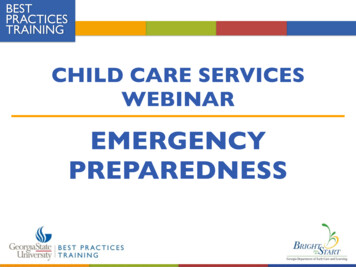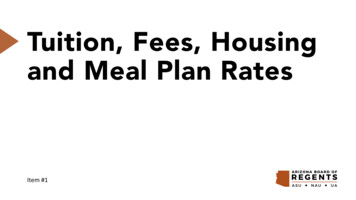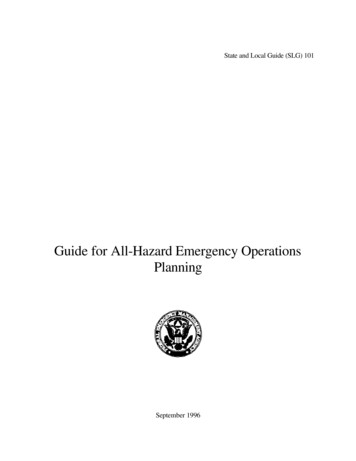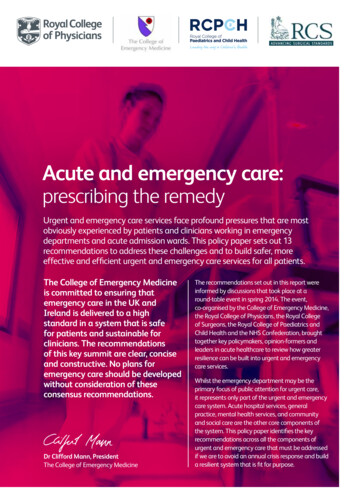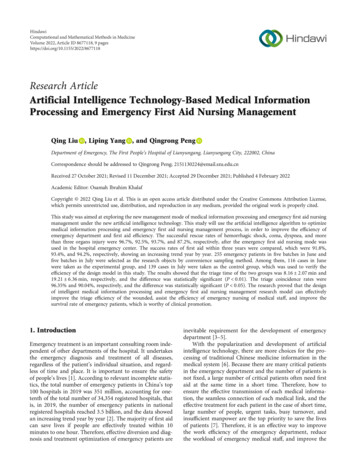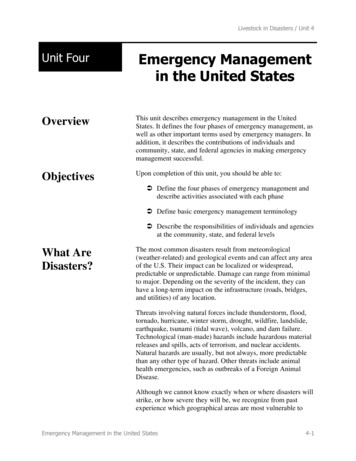
Transcription
Livestock in Disasters / Unit 4Unit FourEmergency Managementin the United StatesOverviewThis unit describes emergency management in the UnitedStates. It defines the four phases of emergency management, aswell as other important terms used by emergency managers. Inaddition, it describes the contributions of individuals andcommunity, state, and federal agencies in making emergencymanagement successful.ObjectivesUpon completion of this unit, you should be able to:Ü Define the four phases of emergency management anddescribe activities associated with each phaseÜ Define basic emergency management terminologyÜ Describe the responsibilities of individuals and agenciesat the community, state, and federal levelsWhat AreDisasters?The most common disasters result from meteorological(weather-related) and geological events and can affect any areaof the U.S. Their impact can be localized or widespread,predictable or unpredictable. Damage can range from minimalto major. Depending on the severity of the incident, they canhave a long-term impact on the infrastructure (roads, bridges,and utilities) of any location.Threats involving natural forces include thunderstorm, flood,tornado, hurricane, winter storm, drought, wildfire, landslide,earthquake, tsunami (tidal wave), volcano, and dam failure.Technological (man-made) hazards include hazardous materialreleases and spills, acts of terrorism, and nuclear accidents.Natural hazards are usually, but not always, more predictablethan any other type of hazard. Other threats include animalhealth emergencies, such as outbreaks of a Foreign AnimalDisease.Although we cannot know exactly when or where disasters willstrike, or how severe they will be, we recognize from pastexperience which geographical areas are most vulnerable toEmergency Management in the United States4-1
Livestock in Disasters / Unit 4certain types of natural hazards. This knowledge helps us betterprepare for and respond to natural hazards. When you readthrough Units 5 – 15 on natural hazards, remember that eachtype of hazard has unique characteristics, yet commonelements. These common elements allow you to prepare forand protect yourself and your animals from disaster.Four Phases ofEmergencyManagementEmergency managers think of disasters as recurring eventswith four phases: Mitigation, Preparedness, Response, andRecovery.The following diagram illustrates the relationship of the fourphases of emergency management.The significance of the emergency management cycle is that allcommunities are in at least one phase of emergencymanagement at any time.4-2Emergency Management in the United States
Livestock in Disasters / Unit 4MitigationThis phase includes actions taken to prevent or reduce thecause, impact, and consequences of disasters. Examples ofhazard mitigation include:Ü Tying down homes or barns with ground anchors towithstand wind damageÜ Digging water channels to redirect water and plantingvegetation to absorb waterÜ Constructing levees or permanent barriers to controlfloodingÜ Reinforcing fencing to prevent animal escapesÜ Buying insurance policiesPreparednessThis phase includes planning, training, and educationalactivities for events that cannot be mitigated. Examplesinclude:Ü Developing disaster preparedness plans for what to do,where to go, or who to call for help in a disasterÜ Exercising plans through drills, tabletop exercises, andfull-scale exercisesÜ Creating a supply list of items that are useful in adisasterÜ Walking around a farm and identifying possiblevulnerabilities to high windsEmergency Management in the United States4-3
Livestock in Disasters / Unit 4ResponseThe response phase occurs in the immediate aftermath of adisaster. During the response phase, business and otheroperations do not function normally. Personal safety and wellbeing in an emergency and the duration of the response phasedepend on the level of preparedness.Examples of response activities include:Ü Implementing disaster response plansÜ Conducting search and rescue missionsÜ Taking actions to protect yourself, your family, youranimals, and othersÜ Addressing public perceptions about food safetyRecoveryDuring the recovery period, restoration efforts occurconcurrently with regular operations and activities. Therecovery period from a disaster can be prolonged. Examples ofrecovery activities include:Ü Preventing or reducing stress-related illnesses andexcessive financial burdensÜ Rebuilding damaged structures based on advancedknowledge obtained from the preceding disasterÜ Reducing vulnerability to future disastersDefinitions ofEmergencyand DisasterThe terms emergency and disaster often are usedinterchangeably. This common use of terms can be confusing.EmergencyAt one end of the spectrum, emergencies are usually smallscale, localized incidents which are resolved quickly usinglocal resources. However, small-scale emergencies can escalateinto disasters when there has been inadequate planning andwasteful use of resources.4-4It is easiest to understand the terms emergency and disaster asbeing at two ends of a scale, in which the size of an incidentand the resources to deal with the incident are matched tovarying degrees.Emergency Management in the United States
Livestock in Disasters / Unit 4DisasterAt the other end of the spectrum, disasters are typically largescale and cross geographic, political, and academic boundaries.Disasters require a level of response and recovery greater thanlocal communities can provide.Emergencies anddisasters and thelivestock industryEmergencies and disasters involving livestock also vary indegree, depending on the amount and availability of neededresources. The degree to which an incident results in a disasterdepends on the size of the event and local response andrecovery capabilities. In many cases, levels of preparedness,response, and recovery capabilities go hand-in-hand.For example, in the 1998 ice storm in the northeastern U.S., themost critical agricultural need was for electrical generators.Dairy farms suffering power outages depended on electricity tomilk their cows.Farmers who had adequate-sized generators and who knewhow to operate them faced an emergency because they wereonly temporarily prevented from milking their cows.In contrast, farmers without generators, or with generators thatfailed due to lack of adequate maintenance or fuel, were facedwith disastrous consequences. They could not milk their cowsand suffered great production losses. Their cows became illand, in some cases, died.Foreign animaldiseaseForeign Animal Disease outbreaks, such as Foot and MouthDisease or Classical Swine Fever (Hog Cholera), could have anegative impact on the national food supply and pose a majorthreat to production and international trade. Coordinationamong local, state, and federal agencies is key to minimizingthe impact of such diseases.Emergency Management in the United States4-5
Livestock in Disasters / Unit 4DefinitionsUsed byEmergencyManagersThe Federal Emergency Management Agency (FEMA) is theagency that promotes disaster mitigation and readiness andcoordinates response and recovery following the declaration ofa major disaster. FEMA defines a disaster as:Levels of disastersEmergency managers further classify emergencies anddisasters by size and the type and number of issues that need tobe addressed. This classification involves minor emergencies,limited and potential emergencies, and major disasters.Minor emergencies“an event that results in large numbers of deaths andinjuries; causes extensive damage or destruction offacilities that provide and sustain human needs; producesan overwhelming demand on state and local responseresources and mechanisms; causes a severe long-termeffect on general economic activity; and severely affectsstate, local, and private sector capabilities to begin andsustain response activities.”Ü Examples:Ø Residential firesØ Livestock barn firesØ Localized chemical spillsØ Livestock trailer wrecksØ Power outages to animal-related businesses (farms,veterinary practices)Ø Storm damage (wind, hail, ice)Ü Issues:Ø Temporary accommodation for people and animalsØ Testing, transport, and certification of animals forslaughter4-6Emergency Management in the United States
Livestock in Disasters / Unit 4Limited and potentialemergenciesÜ Examples:Ø Localized floodingØ Hurricane warningØ DroughtsØ Presumptive diagnosis of foreign animal diseaseØ Nuclear reactor failureØ Tsunami warningÜ Issues—same as for minor emergencies, plus:Ø Notice of evacuation of animal owners and animalsØ Isolation of areaØ Disaster intelligence (e.g., mapping of a plumezone)Major disastersÜ Examples:Ø Large-scale floodingØ HurricaneØ EarthquakeØ Foreign animal disease outbreakÜ Issues—same as for limited and potential emergencies,plus:Ø Disease control interventionsØ Evacuation failures of animal ownersØ Animal rescue attemptsØ Carcass disposalØ Temporary accommodation for owners of animalsEmergency Management in the United States4-7
Livestock in Disasters / Unit 4DisasterdeclarationsDisasters are declared using established guidelines andprocedures. Because all disasters are local, they are initiallydeclared at the local level. This declaration is made by the localChief Elected Official (CEO) (mayor, city manager,commissioner). Only when the CEO determines that localresources capabilities have been or are expected to be exceededwill the CEO of a community request state assistance. If thestate chooses to respond to a disaster, the Governor of the statewill direct implementation of the state’s emergency plan.Again, if the Governor determines that the resource capabilitiesof the state are exceeded, the Governor can request that thePresident declare a major disaster in order to make federalresources and assistance available to qualified state and localgovernments. This ordered sequence is important to ensureappropriate financial assistance.FinancialAssistance inDisastersFinancial assistance is available on a supplemental basisthrough an application process. The Governor reviews the localgovernment’s application, studies the damage estimates and, ifappropriate, declares the area a state disaster. This officialdeclaration makes state resources available. However, ifdamages are so extensive that the combined local and stateresources are not sufficient, the Governor applies to thePresident for federal disaster assistance.If the need for federal assistance funds is justified, thePresident issues a major disaster declaration and federalresources become available. This system ensures that state andfederal limited resources are used wisely and fairly, and theneeds of disaster victims are met.To see an updated map illustrating the most recent presidentialdisaster declarations, as well as useful information about thetypes of disasters that result in declarations, go tohttp://www.bakerprojects.com/fema/mapmain.State ofEmergency4-8Disaster declarations are different than states of emergency. Astate of emergency is declared when public health or theeconomic stability of a community is threatened andextraordinary measures of control may be needed. Examplesinclude a disease outbreak in people (public health) or animals(economic stability, food security).Emergency Management in the United States
Livestock in Disasters / Unit 4MakingEmergencyManagementWorkEmergency management works when individuals, thecommunity, the state, and federal government agencies fulfilltheir emergency management responsibilities. Following is adiscussion of each.Individual rolesAnimal owners, including livestock producers, are individuallyresponsible for animals under their care. In disasters, livestockproducers have three concerns: human safety, livestock safety,and protection of their property. To protect against threats,responsible livestock producers prepare themselves byconstructing a safe environment and by acquiring adequateresources to ensure their safety. Personal preparedness includeshaving effective biosecurity measures and early reporting ofsuspect Foreign Animal diseases to officials.The goal of local emergency management programs is for thepublic to be as prepared as possible. Prepared livestockproducers need less outside help and can expect fewer losses.Personal preparedness is the most effective level ofpreparedness to minimize losses in disasters.Throughout this course, you will learn how to develop yourown emergency contingency plans.Communityagencies’ rolesCommunity (local) governments make plans and provideresources to protect their citizens from the hazards that threatentheir communities. Mitigation activities, preparedness plans,responses to emergencies, and recovery operations areexamples of this effort. Wherever you live within the U.S., acounty or municipal agency is designated as your localemergency management agency.The local government level is the most important at which tointegrate emergency management plans because localgovernments serve as the link between you and the state andfederal agencies in the emergency management network.Local law specifies a chain of command in emergencies. Itspells out who reports to whom. The chief executive officer orjurisdiction manager creates effective emergency services.Emergency Management in the United States4-9
Livestock in Disasters / Unit 4State agencies’rolesThe state emergency management office is responsible forprotecting communities and citizens within the state. The stateoffice carries out statewide emergency management activities,helps coordinate emergency management activities involvingmore than one community, or assists individual communitieswhen they need help. If any community lacks the resourcesneeded to protect itself or to recover from a disaster, the statemay help with money, personnel, or other resources.Federal agencies’rolesFEMAAt the federal level of government, FEMA is involved inmitigation, preparedness, response, and recovery activities.FEMA also helps the states by providing the followingprograms:Ü Training programs and research information on thelatest mitigation measuresÜ Review and coordination of state emergency plansÜ Financial assistanceÜ Flood insurance to individuals and businesses incommunities that join the National Flood InsuranceProgram (NFIP)Ü Subsidies to state and local offices of emergencymanagement for maintaining emergency managementprogramsÜ Guidance and coordination for plans to warn andprotect the nation in national security emergenciesÜ Coordination of services for disaster response andrecovery activities. In addition, FEMA may providesupplemental resources when communities and statesdo not have sufficient resources to protect or assist theircitizens, restore essential services that can get the localeconomy going again, and meet the disaster-relatedneeds of individuals.4-10Emergency Management in the United States
Livestock in Disasters / Unit 4FEMA is your principal source of federal assistance foreducation in disaster management. It provides a variety oftraining opportunities, including this course. Many of FEMA’scourses are taught through your state emergency managementagency. FEMA also provides classroom instruction andoperates the National Emergency Training Center, which offershigher-level courses in emergency management.USDAWhile FEMA coordinates assistance to businesses andindividuals during disasters, the U.S. Department ofAgriculture (USDA) has various programs and authorities toprovide assistance to livestock producers and farmers after amajor disaster.Other federal agencies involved in disasters include theEnvironmental Protection Agency (EPA), the Department ofHealth and Human Services (DHHS), and the Small BusinessAdministration (SBA). Their roles are discussed in detail inUnit 17, in the Appendix for Unit 10, and throughout thecourse. In addition, the federal government supports thecollection of information in databases such as the NationalWeather Service (www.nws.gov) and the United StatesGeological Survey (www.usgs.gov), which are important todisaster management.Emergency Management in the United States4-11
Livestock in Disasters / Unit 4Directions: Determine if the following statements are true orfalse based on the material presented in the unit. When youhave finished, check your answers on page 4-15.Learning Check1.A farmer purchases a snowmobile to allow him to getwater and feed to his cattle in case of a major winterstorm. This is a preparedness activity.True or False?2.A farmer builds a new horse barn with materials designedto withstand the effects of wind, flying debris, andpouring rains. This is a mitigation activity.True or False?3.A group of farmers plan for a hurricane by dividing upresponsibilities for communication, evacuation, and feedsupplies among themselves. This is a preparednessactivity.True or False?4.A farmer invites a local fire inspector to his property toadvise on fire safety and hazardous materials storage.This is a response activity.True or False?5.After a severe summer storm, there is concern that thewater tanks for horses have been contaminated. Toprevent illness, the owners thoroughly clean the tanksbefore they let their horses drink from them. This is amitigation activity.True or False?4-12Emergency Management in the United States
Livestock in Disasters / Unit 4Learning Check6.After an avalanche, several horses and riders are missing.A search team is dispatched. This is a response activity.True or False?7.Months after a flood, farmers begin creating lists ofthings they could do to lessen the impact of futuredisasters. This is a preparedness activity.True or False?8.Several weeks after a flood, there is concern that a wellsupplying drinking water to beef cattle has becomecontaminated. To minimize the risk to the cows, theowner tests the water quality weekly for bacterialcontamination. This is a recovery activity.True or False?9.Emergencies that are large-scale can always be dealt withusing existing resources.True or False?10. Disasters are usually large-scale events in which there areinadequate resources to meet the needs of the affectedcommunity.True or False?Emergency Management in the United States4-13
Livestock in Disasters / Unit 4Learning Check11. Personal preparedness is the most effective level at whichthe losses from disasters can be minimized.True or False?12. Most natural disasters affect local communities first.True or False?13. Disasters are declared starting at the federal, then state,then local level.True or False?14. An important role of FEMA in disasters is coordinationof preparedness and mitigation activities in declaredmajor disasters.True or False?15. The U.S. Department of Agriculture (USDA) has variousprograms and authorities to provide assistance tolivestock producers after a major disaster.True or False?4-14Emergency Management in the United States
Livestock in Disasters / Unit 4For every question that you answered incorrectly, review thepage listed next to the answer to find out why your answer 4-49.False.4-510. True.4-511. True.4-912. True.4-813. False.4-814. False.4-1015. True.4-11Emergency Management in the United States4-15
Livestock in Disasters / Unit 4Summary4-16This unit defined the four phases of emergency managementand described activities associated with each phase. It alsodistinguished between the terms emergency and disaster,explained how each one relates to livestock producers, and howpreparedness can reduce losses in disasters. Finally, this unitdescribed the roles of community, state, and federal agenciesconcerning emergency management.Emergency Management in the United States
Response The response phase occurs in the immediate aftermath of a disaster. During the response phase, business and other operations do not function normally. Personal safety and well-being in an emergency and the duration of the response phase depend on the level of preparedness.


